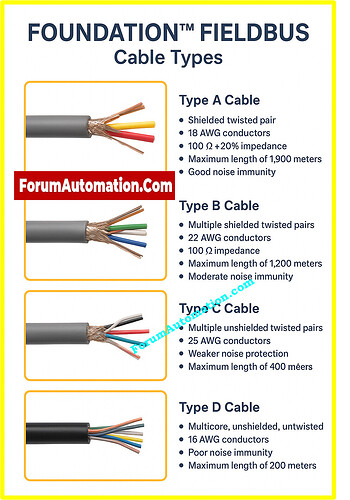What type of cable is used for FOUNDATION fieldbus?
What type of cable is used for FOUNDATION fieldbus?
In industrial settings, FOUNDATION™ fieldbus needs certain cables to make sure that data is sent reliably, power is delivered, and noise is kept out. variety A fieldbus cable is the most common and preferred variety, although the specification also lets you use other types of cables (B, C, and D) for retrofits or existing installations.
-
Type A Cable: Type A Cable is the best choice for FOUNDATION fieldbus H1 networks. It has a shielded twisted pair of 18 AWG wires with 90% shield coverage, a characteristic impedance of 100 Ω ±20% at 31.25 kHz, and a loss of 3 dB/km at 39 kHz. Type A can sustain networks that are up to 1,900 meters long, making it the most reliable and popular choice.
-
Type B Cable: Type B has 100 Ω impedance and is made up of several shielded twisted pairs of 22 AWG wires. It also has higher resistance and a shorter maximum segment length of 1,200 meters. It is occasionally utilized when there are already shielded cables.
-
Type C Cable: Has several unshielded twisted pairs of 26 AWG wires, although it doesn’t protect against noise as well. The maximum length goes down to 400 meters, which makes it not useful for most industrial uses.
-
Type D Cable: This type of cable has 16 AWG wires that are unshielded, untwisted, and have several cores. It doesn’t block noise very well and can only be 200 meters long at most. It is not often advised.
Type A shielded twisted-pair cable is the industry standard for FOUNDATION fieldbus H1 networks. It offers the optimum balance of noise immunity, segment length, and long-term durability.
